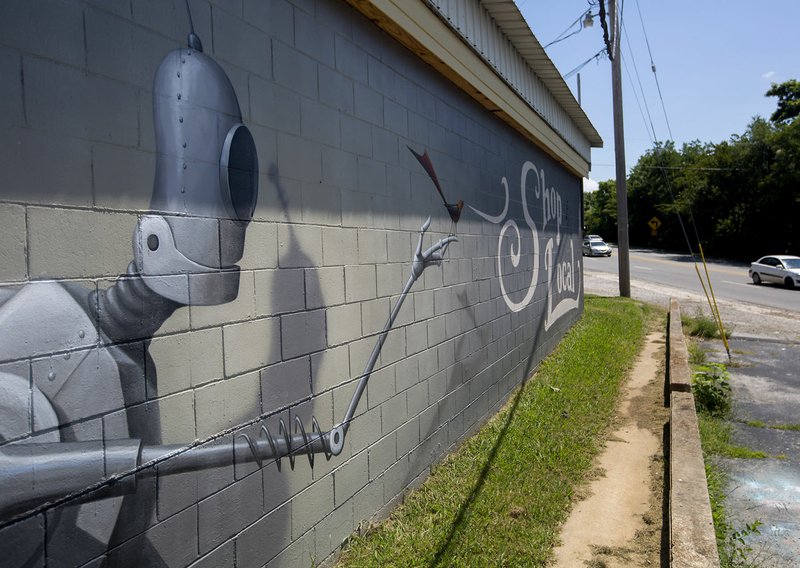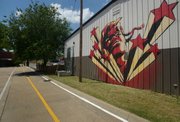Enjoy Local, the mural painted by artist Jason Jones implores visitors of the Fayetteville Town Center square. Area residents and visitors have the chance to enjoy more local art than ever before as cities increasingly make public art a priority.
Having iconic, focal points make for great meeting places, points of reference and are a chance to reflect regional identity, local art commissioners said.
Art all around us
Four Springdale traffic boxes are being converted to art, with plans for more locations in the future. In addition to photos, the boxes also have information explaining the importance of the images and the historical significance. Intersections where you can find the installations:
• Sunset and Thompson
• Maple and Thompson
• Old Missouri Road and Emma Avenue
• Emma Avenue and Thompson
Source: Staff report
Fayetteville has had the longest formal artistic presence of the four large cities in the two-county area. The Fayetteville Arts Council was established in 2007 to "encourage the planning, placement and maintenance of public displays of art within the community," according to its website.
The Fayetteville Advertising and Promotion Commission established a new program this year to ensure public displays of visual art would be funded and the selection process would be systematic. It dedicated more than $100,000 for public art in 2016.
"Prior to that, it hadn't had a funding stream for public art," said Dede Peters, community outreach coordinator for Fayetteville. "Public art depended on donations."
On occasion, Fayetteville Parks and Recreation would set aside funds for public art from its budget, Peters said. But this year is the first time continuous funding for it is guaranteed.
A Fayetteville Art Walk map shows visitors 49 places where they can view public art, primarily in the downtown and University of Arkansas campus area. It's grown to include many benches, creatively shaped and colored bike racks, sculptures, painted traffic boxes, as well as six murals and 12 storm drains covered by Upstream Art, an organization that intends to educate people about the connectivity of drains and creeks to cut down on pollution.
The peace fountain in Town Center Plaza, created by local artist Hank Kaminsky, and the Wilson Park castle are popular because people can interact with them, Peters said.
"The most popular one is the Wilson Park castle," Peters said. "It's just a part of your life. People get married there, birthday parties take place there and kids play there."
The peace fountain is a hit because guests can spin the installation that has water running down its sides. The interaction cools people off during the summer and amazes them when it's frozen over in the winter, Peters said.
Maintenance and cleaning for the large work requires several thousand dollars each year and is paid for by the Fayetteville Visitors Center.
Works expected to arrive later this year include two crosswalks -- one in the area of Washington Elementary School and one in front of the Walton Arts Center -- and a mural along the Tsa la gi Trail funded by a grant from the State Department of Finance and Administration.
The Bentonville Public Art Committee has been in existence since 2012. It has $70,000 to work with this year -- $20,000 from the city and $50,000 from Visit Bentonville. In previous years, the committee organized the acquisition of two sculptures -- orange spokes called SunKissed created by Nathan S. Pierce and a hiking figure dubbed PAC-Man by Craig Gray along the North Bentonville Trail.
Two prior projects were temporary installations, including Ozarks Topography, a stained glass sculpture along the North Bentonville Trail, and NuPenny's last stand, a vending machine like structure filled with midcentury toys, which was in downtown Bentonville.
The city also has six Upstream art installations.
The committee did a public call for artists earlier this summer in making plans for its next installations -- seven bicycle tunnel murals and one crosswalk -- because it's rare that artists approach the committee on their own, said Shelli Kerr, planning services manager for Bentonville.
"Because of Crystal Bridges' influence, the committee felt that we should start expanding the availability of public art in the community," Kerr said.
Things are moving in that direction. The plan for the seven tunnels was approved by Bentonville City Council on Tuesday, and the council will review the crosswalk plan on July 26.
"The value of public art is multilayered for a community like ours," said Chad Alligood, a committee member and curator at Crystal Bridges Museum of American Art. "We have explosive growth and development. The renaissance is happening in the region on all levels, and part of that development of the civic fabric has to be the presence of art."
Many of the other artworks visible to Bentonville visitors are privately funded or on privately owned buildings that are visible to the community. That's primarily how public art is growing in Springdale and Rogers, too, whose public art organizations are in their infancy.
Highly visible works, such as the Coca-Cola mural in downtown Rogers, the sun mural on the windows of the Rogers Opera House and a plan for a mural on the side of a salon on West Elm, which was approved by the Rogers Historic Commission on Wednesday, are privately funded projects.
"Our biggest challenge is funding," said Roger Reithemeyer, chairman of the Rogers Public Art Commission. "We don't have the funds available to solicit artists, but we hope to be there at some point in the near future."
Since the formation of the commission in 2014, a series of metalworks in the likeness of daisies, apples, butterflies and other creatures have popped up in the landscaping bump outs of downtown Rogers. Reithemeyer said they were created by local artists Tom Flynn and Michael Reese and donated by the Downtown Merchants Group.
Within the next month, plans call for a piano to be painted in bright, cheery colors and installed in Rogers Centennial Park. The commission approved the donation by Rogers resident and business owner Julie Colgan, who approached the art commission with the idea.
"I thought this was a neat way for people to see something and interact with it, that maybe it would get them off their phone for a bit," Colgan said in a commission meeting Thursday.
Colgan got the idea from someone who visited The Rusty Chair, her antique store. She found someone willing to donate a piano and arranged for a Bentonville artist to paint it. She also offered to be responsible for protecting it from the elements when major storm systems move in.
Two murals in Springdale, at The Jones Center and the Perrodin Supply Co., were also privately funded. The most recent public art project is the painting of four traffic boxes, three of them along Thompson Avenue, through a grant by the Boston Mountain Solid Waste District, said Melissa Reeves, director of public relations for Springdale.
The Springdale Art Initiative, formed in 2014, led to a number of art installations including a mural for the Springdale Aquatic Center, the restoration of a U.S. map at Lee Elementary and a painting of a quilt square installed at the Shiloh Museum meeting hall.
"Public art is going to be really important as we do downtown revitalization," said Misty Murphy, executive director of Downtown Springdale Alliance. Future art installations will "not just be murals and more traditional art, we're looking at participatory, interactive, tactile and experimental works," she said.
One hope for such interactive art is a water swing that creates a waterfall while in full swing, but halts the flow of water while the user is directly under it.
"It used to be that public art was to plop down a sculpture in the middle of a square," Alligood said. "Increasingly, our ideas about public art are things that engage the population."
NW News on 07/25/2016

